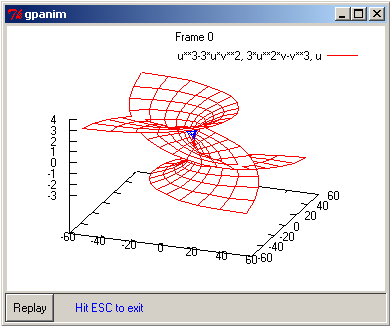GS Gnuplot [
1][
2] is a very flexible command-line 2D/3D plotter. It supports many different types of
terminals like latex, hpgl, postscript, pdf, jpg, svg or tkcanvas. This last may interest us allowing to plot data on canvas with Tcl-Tk (or Perl/Tk, but it is another story ....).
With the tkcanvas
terminal, Gnuplot writes a Tcl procedure in a file that can be sourced. See the online manual for basic explanation [
3]. But it is also easy to control Gnuplot from Tcl-Tk through a command pipeline channel. See for instance [
4] (in french). With this idea and with a few modifications in the Tcl file generated by Gnuplot, we can play a 3D graph animation.

#! /bin/env tclsh
# gpanim.tcl
# Author: Gerard Sookahet
# Date: 14 Feb 2005
# Description: Play animation on canvas thanks to Gnuplot
# Requirement: Gnuplot
package require Tk
bind all <Escape> {exit}
set gpexe gnuplot
# Give a full path to gpexe if your platform is windows
if {$::tcl_platform(platform) == "windows"} then {
set gpexe C:/Prog/Graph/gnuplot-4.0/bin/pgnuplot.exe
}
set outfile [file dirname [info script]]/result.tk
pack [canvas .c -bg white]
pack [frame .f1 -relief sunken -bd 1] -fill x
pack [button .f1.br -text Replay -command {.c delete all;gnuplot .c}] \
[label .f1.l1 -text " Hit ESC to exit" -fg blue] -side left
.c create text 70 30 -text "Calling Gnuplot ...." -fill black -anchor w
set start {
# Start the gnuplot session through a command pipeline channel
set gp [open "|$gpexe" r+]
puts $gp "set term tk"
puts $gp "set output '$outfile'"
puts $gp "set parametric"
puts $gp "set hidden3d"
puts $gp "set isosamples 18"
puts $gp "set autoscale"
puts $gp "set view 60,20"
puts $gp "set urange \[-3:3\]"
puts $gp "set vrange \[-3:3\]"
puts $gp "set title \"Frame 0\" "
puts $gp "splot u**3-3*u*v**2,3*u**2*v-v**3,u"
set t [.c create text 70 50 -text "Processing frame 0" -fill black -anchor w]
set k 0
# Perform rotation around z-axis
set i 40
main $frames
}
set frames {
incr k
puts $gp "set view 60,$i"
puts $gp "set title \"Frame $k\" "
.c itemconfigure $t -text "Processing frame $k"
puts $gp "replot"
incr i 20
if {$i <= 160} {
set next $frames
} else {
close $gp
.c create text 70 70 -text "Loading data" -fill black -anchor w
set next $load
}
main $next
}
set load {
set fp [open $outfile r]
set data [read $fp]
close $fp
set data [split $data "\n"]
set j 0
set k 6
set n [llength $data]
incr n -1
set f1 [open $outfile w]
foreach i [lrange $data 0 5] {puts $f1 $i}
# modification of the output file
for {set k 32} {$k <= $n} {incr k} {
set i [lindex $data $k]
if [string match "proc*" $i] {
incr j
puts $f1 "after 200"
set i "# frame $j"
} elseif [string match "set" $i] {
set i "#"
} elseif [string match "if" $i] {
set i "#"
} elseif [string equal "\}" $i] {
set i "#"
puts $f1 "update"
}
puts $f1 $i
}
puts $f1 "\}"
flush $f1
close $f1
# Play the animation
source $outfile
gnuplot .c
}
proc main script {
after 200 $script
}
main $start


